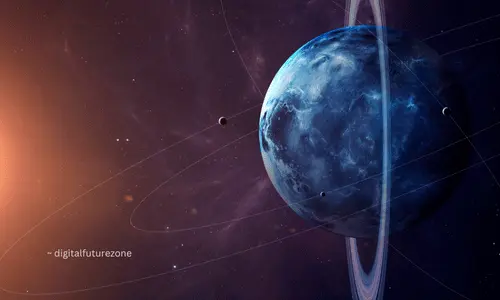The particles that are flying through Uranus have been being subject to “traffic jams,” a mysterious phenomenon that has fascinated scientists for a long time. Recent studies provided a better understanding of the root causes of this peculiar phenomenon in the universe by revealing how Uranus’ low radiation belts as well as its oddly inclined magnetic field are the cause of these delays.

The mystery of Uranus’s Magnetic Field This mystery goes back to the beginning of January, 1986 the time that NASA’s Voyager 2 spacecraft visited Uranus. In this mission, Voyager 2 discovered that Uranus’s magnetic field was symmetrical and inclined at around 60deg to Uranus’s spin axis. It was a significant discovery because many planets, such as Earth, Jupiter, and Saturn possess magnetic fields that are aligned closer to their axes of rotation, making an angular dipole that is more typical.
Weak radiation Belts Voyager 2 also discovered that the radiation belts around Uranus full of particles that were trapped by the magnetic field and were 100 times stronger than what was expected. These are the regions that are where charged particles get caught by the magnetic field of Uranus and create zones of intense radiation. The low radiation intensity of the belts was an interesting discovery which puzzled scientists for a long time.
Recent Research as well as Simulations The most recent study, built from studies with Voyager 2 data, indicates that two peculiar aspects of Uranus – the faint radiation belts as well the magnetic field that is tilted. According to lead researcher Matthew Acevski, Uranus’s magnetic field is different from any other that exists in this solar system. It’s highly asymmetric, and is becoming increasingly closer to the surface of Uranus. The magnetic asymmetry is believed to alter the shape of the proton radiation belts. This causes zones where the belts are compressed more than other regions where the belts are much more dispersed.
The impact from the Magnetic Asymmetry Acevski’s theory reveals the ways in which the magnetic asymmetry of Uranus impacts the protons radiation belts. When belts are tense their radiation intensity becomes higher, whereas in regions that have the belts more dispersed, their strength is lower. The warping effect may explain the reason Voyager 2 observed weaker-than-expected proton radiation belts as it flew across a zone where belts were scattered.
the Oddities of Uranus Uranus is a unique among stars in the solar system. It’s the coldest of planets and its temperatures can drop to -224 degrees Celsius, and also it is rotated in a 97-degree tilt to its orbital plane making it almost a horizontal orientation. The extreme tilt, coupled with the unique magnetic field makes for a complicated and a dynamic ecosystem which is currently being researched and analyzed.
Conclusion: Uncovering Uranus’s Mysteries of Uranus Discovering the existence of “traffic jams” around Uranus gives new understanding of Uranus’s complicated magnetic field as well as radiation belts. Knowing these patterns can benefit scientists understand the structure of Uranus as well as its interplay with the Solar System. While research continues, Uranus’ unique features will shed light on the intricate nature of planet magnetism as well as the nature of cosmic particle.
FAQs:
What’s the cause of the “traffic congestion’ that occurs around Uranus? The ‘traffic jams’ occur due to Uranus’s tilted and symmetrical magnetic field that warps its proton radiation belts producing regions with varying intensities of radiation.
The date when the magnetic Asymmetry of Uranus found? The magnetic asymmetry of Uranus was found through NASA’s Voyager 2 spacecraft on its trip to Uranus in the month of January, 1986.
What makes Uranus’s magnetic field differ the other solar systems? Unlike the more conventional dipole magnetic fields found on planets such as Earth, Jupiter, and Saturn Uranus’s magnetic field is extremely asymmetrical and has a tilt of around 60 degrees away from the spin axis. This peculiar field shape influences the radiation belts of Uranus as well as particles motion.
